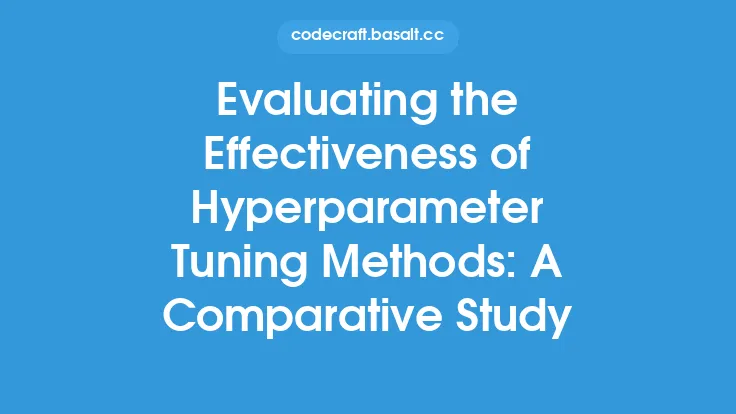Evaluating the performance of a machine learning model is a crucial step in the model development process. It allows practitioners to assess the model's ability to make accurate predictions, identify areas for improvement, and compare the performance of different models. In this article, we will delve into the various metrics and methods used to evaluate model performance, providing a comprehensive guide for machine learning practitioners.
Introduction to Model Evaluation Metrics
Model evaluation metrics are used to quantify the performance of a machine learning model. These metrics provide a way to measure the model's accuracy, precision, recall, and other important aspects of its performance. The choice of metric depends on the specific problem being addressed, the type of data, and the goals of the project. Common metrics used in model evaluation include accuracy, mean squared error, mean absolute error, precision, recall, F1 score, and area under the receiver operating characteristic curve (AUC-ROC). Each of these metrics provides a unique perspective on the model's performance, and understanding their strengths and limitations is essential for effective model evaluation.
Classification Metrics
Classification metrics are used to evaluate the performance of models that predict categorical outcomes. Accuracy, precision, recall, and F1 score are commonly used metrics for classification problems. Accuracy measures the proportion of correctly classified instances, while precision measures the proportion of true positives among all positive predictions. Recall measures the proportion of true positives among all actual positive instances, and F1 score is the harmonic mean of precision and recall. AUC-ROC is another important metric for classification problems, as it measures the model's ability to distinguish between positive and negative classes. Understanding these metrics is crucial for evaluating the performance of classification models, as they provide insights into the model's ability to make accurate predictions.
Regression Metrics
Regression metrics are used to evaluate the performance of models that predict continuous outcomes. Mean squared error (MSE) and mean absolute error (MAE) are commonly used metrics for regression problems. MSE measures the average squared difference between predicted and actual values, while MAE measures the average absolute difference. These metrics provide insights into the model's ability to make accurate predictions, with lower values indicating better performance. Other metrics, such as mean absolute percentage error (MAPE) and coefficient of determination (R-squared), can also be used to evaluate regression models. Understanding these metrics is essential for evaluating the performance of regression models, as they provide insights into the model's ability to make accurate predictions.
Evaluation Methods
In addition to metrics, there are several evaluation methods that can be used to assess model performance. Cross-validation is a widely used method that involves splitting the data into training and testing sets, and evaluating the model's performance on the testing set. This method provides a more accurate estimate of the model's performance than evaluating on a single testing set. Bootstrapping is another method that involves resampling the data with replacement, and evaluating the model's performance on the resampled data. This method provides a way to estimate the variability of the model's performance, and can be used to compare the performance of different models.
Model Selection and Hyperparameter Tuning
Model selection and hyperparameter tuning are critical steps in the model development process. Model selection involves choosing the best model for a given problem, based on its performance on a testing set. Hyperparameter tuning involves adjusting the model's hyperparameters to optimize its performance. Grid search, random search, and Bayesian optimization are commonly used methods for hyperparameter tuning. These methods involve searching the hyperparameter space to find the optimal combination of hyperparameters that results in the best performance. Understanding these methods is essential for developing high-performing models, as they provide a way to optimize the model's performance and choose the best model for a given problem.
Model Evaluation in Practice
In practice, model evaluation involves a combination of metrics and methods. The choice of metric and method depends on the specific problem being addressed, the type of data, and the goals of the project. For example, in a classification problem, accuracy, precision, recall, and F1 score may be used to evaluate the model's performance, along with cross-validation to estimate the model's performance on unseen data. In a regression problem, MSE, MAE, and R-squared may be used to evaluate the model's performance, along with bootstrapping to estimate the variability of the model's performance. Understanding how to apply these metrics and methods in practice is essential for developing high-performing models that meet the needs of real-world applications.
Common Challenges and Pitfalls
There are several common challenges and pitfalls that can arise when evaluating model performance. Overfitting and underfitting are two common issues that can occur when developing models. Overfitting occurs when the model is too complex and fits the noise in the training data, resulting in poor performance on unseen data. Underfitting occurs when the model is too simple and fails to capture the underlying patterns in the data, resulting in poor performance on both training and testing data. Other challenges and pitfalls include data leakage, where information from the testing set is used to develop the model, and class imbalance, where the classes are imbalanced, resulting in biased performance metrics. Understanding these challenges and pitfalls is essential for developing high-performing models that meet the needs of real-world applications.
Best Practices for Model Evaluation
There are several best practices that can be followed when evaluating model performance. First, it is essential to use a combination of metrics and methods to get a comprehensive understanding of the model's performance. Second, it is essential to use cross-validation or bootstrapping to estimate the model's performance on unseen data. Third, it is essential to tune the model's hyperparameters to optimize its performance. Fourth, it is essential to consider the class distribution and potential biases when evaluating the model's performance. Finally, it is essential to document the model evaluation process and results, to provide transparency and reproducibility. By following these best practices, practitioners can ensure that their models are thoroughly evaluated and meet the needs of real-world applications.





